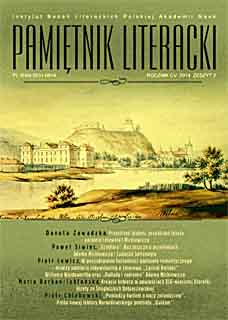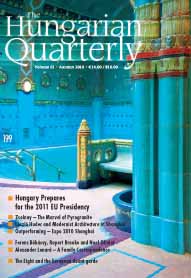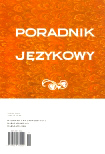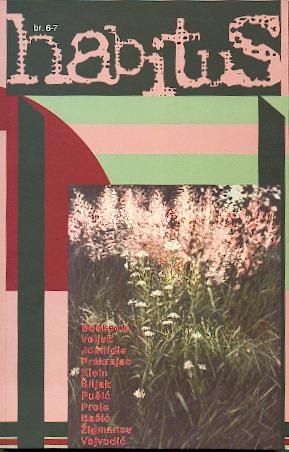![Contents of the Fascile [Polish and English]](/api/image/getissuecoverimage?id=picture_2014_14704.jpg)
![Contents of the Fascile [Polish and English]](/api/image/getissuecoverimage?id=picture_2014_14704.jpg)

Keywords: Juliusz Słowacki; Jarosław Iwaszkiewicz; Zbigniew Herbert; “Juliusz Słowacki – interpretacje i reinterpretacje [Juliusz Słowacki – Interpretations and Reinterpretatios]”
The review of the book “Juliusz Słowacki – interpretacje i reinterpretacje (Juliusz Słowacki – Interpretations and Reinterpretatios)” consists of 14 interpretive sketches in which attention is brought to the lyrical aspect of the poet’s creativity. Presented from different perspectives, Słowacki’s poems become a pretext for a thought about the methodology of reading the pieces, are seen as a source of inspiration for Jarosław Iwaszkiewicz and Zbigniew Herbert, and first and foremost are regarded to be constantly interesting in spite of the passing years with a view to their forms and themes.
More...
In 1910, Szabadság (Freedom), a Hungarian-language daily published in Cleveland, sent out a questionnaire enquiring: Why did you come to America? The majority of respondents said that they hoped for a better standard of living and more pay, whereas others were searching for an adventure. A few, however, were motivated by their civic conscience. One was John Szabó, who had left for America because “I was not a man who has the right to be… an independent and free person” in Hungary.
More...
When people hear the word Zsolnay, beautiful sinuous iridescent-glaze ceramics, table settings and various decorative items come to their minds. Few realize that the gleaming tile roofs of the Matthias Church up on Castle Hill, its flooring and the Madonna over the main west portal are Zsolnay as are the colourful pitched roofs and salt-glaze chimneys as well as the cookie-cutter-like decorative ceramic strips along the brick walls of the Main Market Hall. The stunning blue ceramic roof of the National Geological Institute, its façade inlaid with blue ceramic decorations in the forms of aleolithic molluscs; the twisted blue chimneys issuing from the experimental labs; the awesome multi-colour pitched, tile-covered roofs of the National Bank building on Hold Street are all from the Zsolnay Ceramics Factory of Pécs.
More...
Around a third of Hungarians live in a country neighbouring Hungary—the legacy of the post First World War Treaty of Trianon—and Hungarian-language professional theatres in the one-time Hungarian territories reflect a similar ratio. Ten companies are based in Romania (not counting the Hungarian Opera of the city of Cluj [Kolozsvár] and several puppet theatres), one in Ukraine, three in Serbia and two in Slovakia. Undergraduates receive Hungarian-language instruction at the university of dramatic arts in Taˆrgu Mures¸ (Marosvásárhely) and Cluj, Romania and at the Academy of Dramatic Arts in Novi Sad (Újvidék) in Vojvodina, Serbia.
More...
Balázs Ablonczy, Trianon-legendák (The Trianon Legends). Budapest: Jaffa, 2010. 158 pp.
More...
Alex Bandy, Chocolate and Chess Budapest: Akadémiai Kiadó, 2009, 476 pp.
More...
On a side wall in King’s College Chapel, Cambridge there is a memorial plaque commemorating all members of the College who died serving in the Great War. The second name is that of Rupert Brooke. On the opposite wall there is a small plaque with just one name on it, that of a young Hungarian who had also been a member of the college, Ferenc Békássy. It was the economist John Maynard Keynes, a close friend of Békássy, who had asked the college to include his name among those commemorated. However, as one of the Fellows of King’s who had lost a son in the fighting objected to this on the grounds that Békássy had died fighting the Allies, the name was carved on a separate wall, near the entrance, in fact giving it far more prominence.
More...
For over seventy years, a steady stream of letters was exchanged between Alexander Lenard and members of my family in Memphis, Tennessee. Most of these reflections on everything from stock market prices to family trips, to the legacy of war to the cost of cranberry seeds, were exchanged between Sandor (he was called in the family by his Hungarian first name, without the accent) and my great-uncle William (a.k.a. Bill) Goodman. Luckily for me, my prescient uncle had a heartfelt, insightful appreciation for the epistolary vision he saw in his cousin Sandor’s missives. He kept every letter that he received from Lenard, as well as copies of his own correspondence.
More...
Jack Thompson: Breaking the Cross. Bloomington, Ind.: AuthorHouse, 2008, 341 pp.
More...
It had been a year since I first met Zelma, and it was more out of guilty conscience than love that I equipped myself with a gift for the anniversary. By then I was bored with her. I was not truly in love with her even early on in our relationship; at first I was enthralled by her docility, then by her very wildness, for she turned wild in bed. I became her captive so to say, when I saw her nipples burst out of their pod, her clit emerge, and when I nibble on her calves she turns me into a savage male with her passionate cries, the averting of her eyes and, later on, her deep moaning. All the same, time and habit… In the course of my travels increasingly often I sought (and found) country beauties, and there were times when I did not go near the theatre for days on end. Zelma mutely tolerated this with never even a single word of reproach, and when I returned to her she would look up at me with tearfilled eyes and embrace me. So I equipped myself with a nice gift for the anniversary, which, in strictest confidence, I also conceived of as being a parting gift.
More...

Not long ago I was luxuriating in the steam room of the Rudas Baths. Even the hard-boiled, after several hours of alternating between hot, tepid and cold pools, succumb to a delightful torpor, a state which combines “restful inertness, languorous recumbence, weariness and renewal, this indulgence of indolence,” as one of our great forebears, an émigré who also passed through Turkey after the 1848 revolution, put it.
More...
The Hungarian architect László Hudec (1893–1958) is a name to be reckoned with in China where he settled for a long period, but he is almost unheard of in his home country beyond a tight circle of architectural historians and his extended family. Quite a bit has been written about Hudec outside Hungary: Luca Poncellini, an architecture student from Turin, recently completed a study which is soon to appear as Volume 13 of Holnap Kiadó’s architecture series. It’s odd that he has vanished from collective memory, as tér és forma (‘space and form’), the mouthpiece of modern architecture in the interwar years, featured one of his buildings, and Hudec kept in touch with a number of important Hungarian architects. I first came across his name decades ago when, searching the database of the Research Institute for Art History of the Hungarian Academy of Sciences, I stumbled across a newspaper article from the 1930s: a “Hungarian architect designed the first skyscraper in Shanghai, the first in Asia.”
More...
In January 2011 Hungary will assume the Presidency of the Council of the European Union. Its six-month term will be an interesting period for Hungary and the EU alike. Hungary will coordinate the Council’s vast bureaucratic and decision-making apparatus while not being able to rely on any significant wealth of accumulated knowledge about some of its workings due to the novelty of the Lisbon institutional framework currently being implemented. The EU itself faces a series of intractable but essential policy decisions about the new financial perspectives for 2014–2020 and the “2020” goals, promoting the bloc’s competitiveness, sustainable growth and social cohesion. It must deal with the periodically re-emerging challenge of financing agricultural policy while also setting the pace in external relations in areas as diverse as the Eastern Partnership for post-Soviet states and the thorny integration process of the Western Balkans. Accordingly, Budapest and Brussels share an interest in a successful presidency. Success won’t be measured in breakthroughs or permanent solutions but in terms of progress made in various knotty areas. As a result of the complex and lengthy policymaking processes currently underway, the Hungarian presidency will be mostly concerned with “rolling policies” (inherited issues) and providing follow-up to the mainly Spanish initiatives, since the current Belgian presidency has limited capability and political will to add to the already crowded agenda.
More...

Keywords: telewizja; TV; media; fraternizacja; program telewizyjny;
Among the elements contributing to the formula, which the analyzed TV program is based on, what draws the author's special attention is the language of the program. She highly rates its model as most appropriate to make it popular in communication.
More...
Keywords: przekład; edukacja literacka; Ania z Zielonego Wzgórza; tłumaczenie; Rozalia Bernsteinowa; Przemysław Piekarski;
The main target of this article is to indicate the problem of changes in Polish language. To make the matter more understandable two different translations of the same book (Ann of Green Gables by L. M. Montgomery) were chosen for linguistic analysis. The first translation was made in 1912 by Rozalia Bernsteinowa, the second one in 1995 by Przemys³aw Piekarski. The result of confrontation is very interesting, as changes in Polish society and consequently in all parts of language have been revealed. Generally, Polish literary language seems to use colloquial words, phrases and style more often nowadays than in the past.
More...
